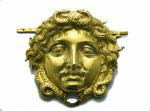Treasures of Heaven : Saints, Relics and Devotion in Medieval Europe

Wonderful exhibition at the British Museum examining devotional objects from medieval Europe in particular reliquaries. It was like falling into a jewel box! I liked the fact it put the objects in context but also acknowledged them as beautiful and sometimes ground breaking objects. Having done a course at the Courtauld earlier this year on early Christian images it was wonderful to see the early items and see how iconography developed. In amongst the gold there were some wonderfully touching items such as St Cuthbert’s personal travelling altar, a really direct connection to the saint. However my favourite items have to be the reliquary for the Holy Thorn with tiny gold figures rising from their graves on the bottom and small gold apostles up the edge. Reviews Times Guardian Daily Telegraph Evening Standard







